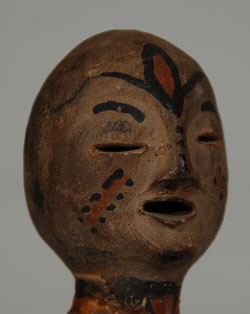Tesuque Pueblo Nineteenth Century Rain God with Feathered Forehead [SOLD]
+ Add to my watchlist Forward to Friend
- Category: Figurines
- Origin: Tesuque Pueblo, TET-SUGEH
- Medium: native clay, pigment
- Size: 5-1/2” tall
- Item # 25570 SOLD
 Santa Fe has always been an exotic destination for tourists even before the arrival of the transcontinental train in 1880. In fact, New Mexico was so foreign to Washington bureaucrats that it was prohibited for over 65 years from becoming a state. Washington politicians saw New Mexico as uneducated, uncivilized and unworthy of becoming a state of the United States so it stayed a territory until 1912. Other Americans did not see New Mexico as that but they saw it as an exotic destination full of mysterious and interesting people.
Santa Fe has always been an exotic destination for tourists even before the arrival of the transcontinental train in 1880. In fact, New Mexico was so foreign to Washington bureaucrats that it was prohibited for over 65 years from becoming a state. Washington politicians saw New Mexico as uneducated, uncivilized and unworthy of becoming a state of the United States so it stayed a territory until 1912. Other Americans did not see New Mexico as that but they saw it as an exotic destination full of mysterious and interesting people.
Santa Fe merchants were quick to pick up on the interests of outsiders to the culture of New Mexico and they were quick to match Indian-made items with those interests. Traditional functional utilitarian pottery was not necessarily of interest to the visitors. Something more exotic with a shock-value, something that would convey the mysteries or religion of the Natives in this untamed land was needed. The merchants settled on clay gods and idols as the perfect answer.
Tesuque rain gods, neither idols nor gods, were the answer and the merchants purchased them by the hundreds and thousands from the potters at Tesuque Pueblo. They were exotic and believed to be representations of idols or gods by the tourists.
This polychrome Tesuque rain god is typical of those made in the late 1800s for sale to tourists. It is the traditional seated figure holding a jar in its lap. The face is painted with tattoo-like markings on the nose and cheeks and a feather on the forehead. There is a scarf around the neck. The pottery jar is decorated.
Condition: the figurine has a wonderful patina. It has previously been broken at the neck but now repaired. The painted scarf around the neck partially conceals the previous break.
Provenance: from a Santa Fe collector
Recommended Reading: When Rain Gods Reigned: From Curios to Art at Tesuque Pueblo by Duane Anderson.
- Category: Figurines
- Origin: Tesuque Pueblo, TET-SUGEH
- Medium: native clay, pigment
- Size: 5-1/2” tall
- Item # 25570 SOLD



